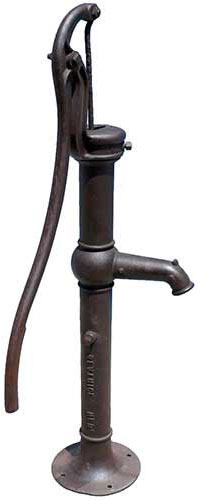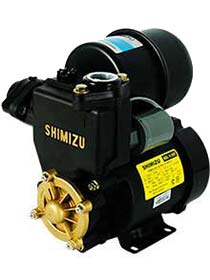Centrifugal Water Pumps
Water Pumps for Household Use
Many of us have water pumps in our houses, shops, offices or hotels. We use them for pumping water out of the ground, for distributing water around the buildings and for filtering our swimming pools and fish ponds.
While there are several different types in common usage it is probable that all will be centrifugal pumps of one type or another. What is a centrifugal pump, how does it work and what variations in design do we use?
- Water pressure problems
- Water pump size
- Solving water pump problems
- Water pump switching on and off
- Water pump pressure tanks

Most of us somewhere around our house will have a water pump of some kind. The more affluent among us may have a pump to circulate the swimming pool water while most of us will have a pump to raise water from a well or bore or to pressurise water in our taps.
Pumps are very important to us and anyone who has seen much of the way country people live in Bali will have noted that where pumps are being used to pipe water from waterways directly to people's houses their lives have been changed. No more do they have to walk down to the river to bathe or wash their clothes but sadly the communal interaction is being lost and the old networks of pathways is growing over.
Centrifugal water pumps
There are many different types of pumps used for different purposes but you can be fairly sure that the ones you are using in your home are "centrifugal" pumps.
The centrifugal water pumps we use have three significant components: an electric motor to drive them, the pump itself which physically moves the water and some switching mechanism to switch them on and off.
The concept of the centrifugal pump is quite simple. An electric, or any other kind of motor, spins a disc which is mounted inside a housing. This spinning disc has a series of radial fins or vanes on it and is called an impellor. A pipe carries water into the pump housing to the centre of the spinning disk. As the disc spins it draws water in and centrifugal force throws the water out and into a specially shaped cavity in the housing around the outer edge of the disc. Another pipe leading from this cavity carries the water away as a flow of pressurised water.
Centrifugal pumps have been around for a while. The world's first centrifugal pump was traced back to 1475 (that's a long time ago even before the internet) but the first true centrifugal pump was designed by Denis Papin in the 1600's. In 1851 a significant improvement was made by John Appold who made the radial vanes on the disc curved which considerably improved the centrifugal effect.
The pump must be strong enough
The pump must be powerful enough for the task it has to perform. Water is pretty heavy stuff and to lift water a height of say 16 metres will take 23 psi (pounds per square inch) of pressure.
If the pump is too small the centrifugal force will not be strong enough to reach the pressure needed to push the water to its destination and the impellor will spin sloshing the water around a bit but without actually moving it. Additionally there is inevitably a small gap between the spinning disc and the housing which will allow some leakage. This is inefficient but does in fact mean that the pump will not destroy itself should something go wrong.
For seriously pushing water we use pumps that are of far more sophisticated designs such as piston or diaphragm pumps. These are known as positive displacement pumps.

Standard Water Pump
The simple, very robust, low cost centrifugal pump is perfectly adequate for our household purposes.
It is important to note that centrifugal pumps are much better at pushing rather than pulling or sucking water, a source of difficulty if we are trying to suck water out of a deep well.
Centrifugal jet pump
We can use a modified centrifugal pump known as a "jet" pump to help with this problem. A jet pump is just like an ordinary centrifugal pump except that there is an extra pipe that carries a small amount of the pressurised water from the outlet of the pump back down the well where it is fed back into the suction pipe part of the way down the well. The pressurised water coming up the pipe helps to lift the water from the bottom of the well.
Submersible pumps
If the water level is too deep for a jet pump to work we can use a "submersible" pump. This is also a type of centrifugal pump but is placed at the bottom of the bore (we are now below the depth to which wells can be dug) to push the water up the delivery pipe. As I said centrifugal pumps are far better at pushing water so submersible pumps are far more effective than standard pumps. They are however considerably more expensive.
Submersible pumps are tall, cylindrical devices, usually made from stainless steel and are fastened to the bottom end of the delivery pipe in your bore. Because they have to fit inside the bore itself they have to be quite small diameter, 75 to 100 mms, which means the pump itself is quite small and not very powerful. To overcome this limitation another trick is used. Several centrifugal pumps are placed one on top of another all driven by a single water proof electric motor mounted on the top. This is called a multistage pump. The outlet of each pump feeds into the one above it and in this way the pressure of water delivered can be progressively increased. The deeper the bore, the more pressure we need and the more stages we add.
Multi stage submersible pumps allow us to pump water from very deep bores (up to 150 metres in some areas such as the Bukit).
The importance of the non return valve
An important consideration with centrifugal pumps is that they don't like air. Air is squashable, in fact far more squashable than a cherub's buttocks, and a pump needs something firm to work on.
When a pump stops the water may drain out of the suction pipe in the well allowing air into the pump. If air gets into the pump the impellor will spin freely in air and will not pump, to get it going the pump will have to be "primed" which involves filling it with water.
To avoid this we put a one way "non return" valve on the bottom end of the delivery pipe to stop the water draining out.
As you can appreciate it is important to get the right size of pump and the size is determined by two factors: the quantity of water that the pump can move and the pressure it can achieve.
See also:
- Water pressure problems
- Water pump size
- Solving water pump problems
- Water pump switching on and off
- Water pump pressure tanks
Phil Wilson
Copyright © Phil Wilson August 2010
This article, or any part of it, cannot be copied or reproduced without permission from the copyright owner.
